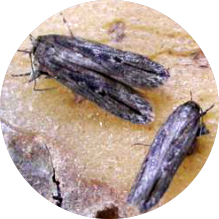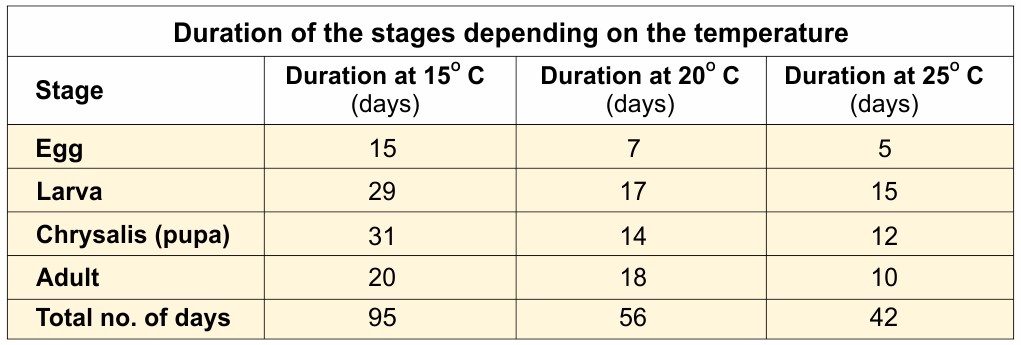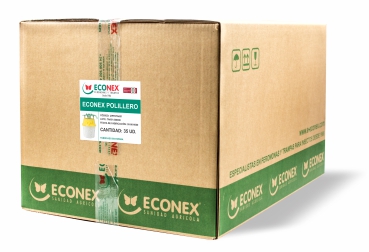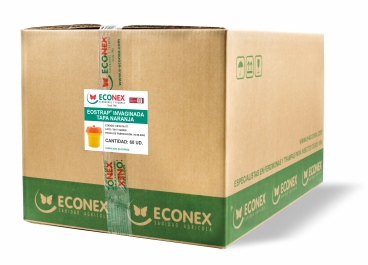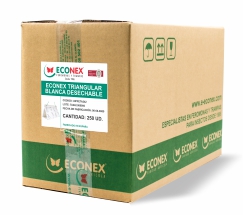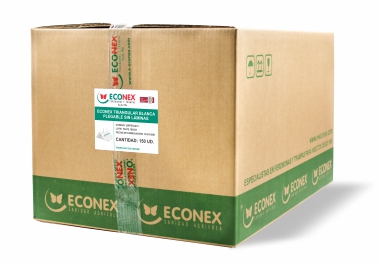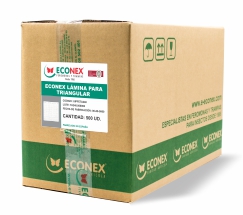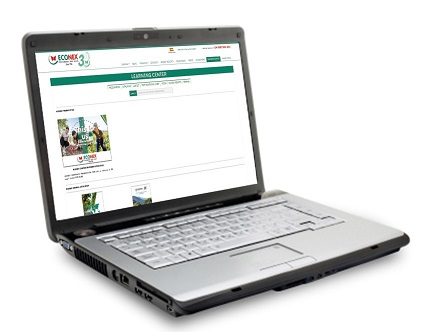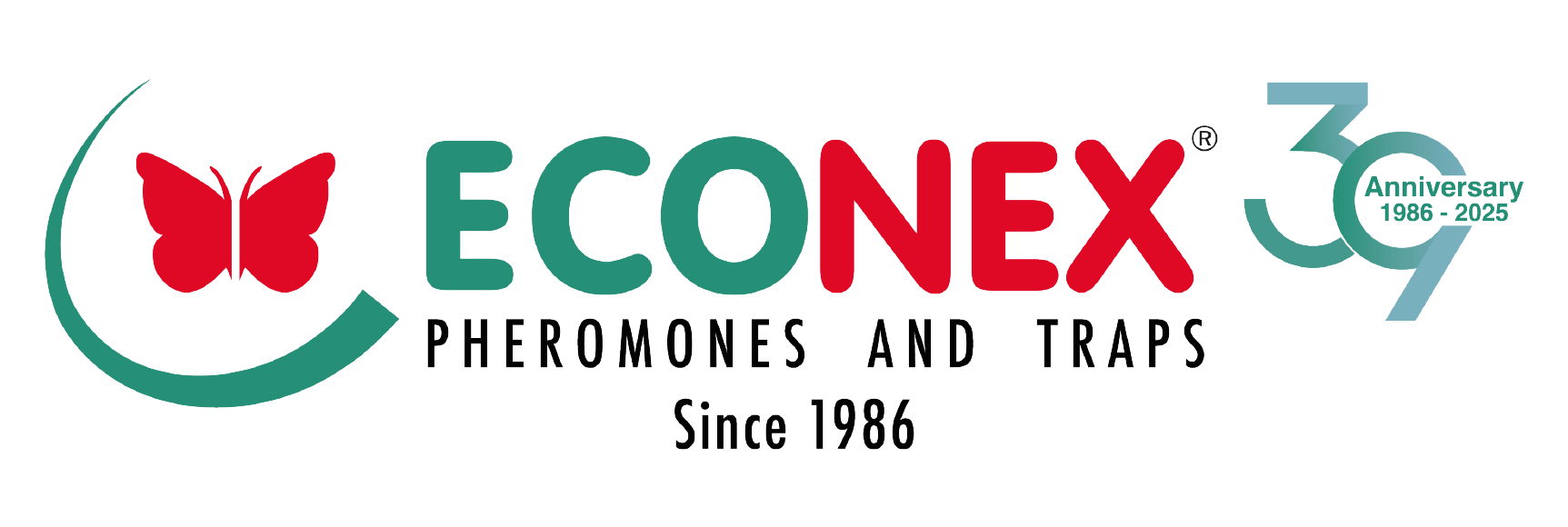Morphology and biology
It only grows on potatoes Solanum tuberosum. CAs with all moths, they are nocturnal and begin their cycle by laying their eggs on the potatoes or near them. They lay between 200 and 500 eggs.
Fertilisation of the eggs reaches 95% and the incubation period can last between 5 and 15 days, depending on the temperature.
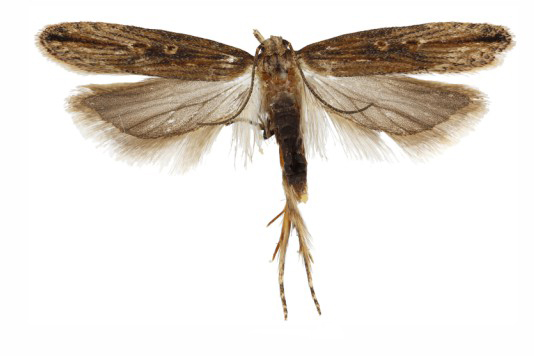
Male
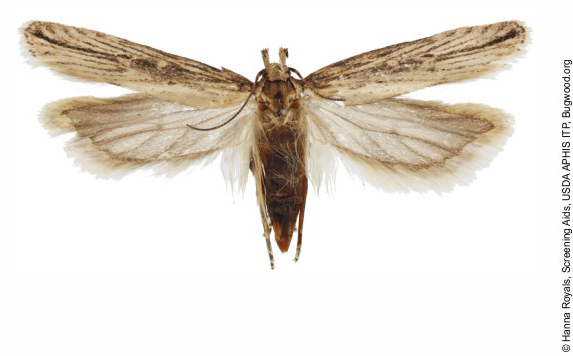
Female
Once hatching occurs, the larva, which measures 1.5 mm and is a creamy white colour, enters inside the potato where it grows. It is responsible for the damage to the potato, characterised by the potato’s loss of weight and quality.
At the end of the larval phase, which lasts between 15 and 29 days, the larva abandons the potato measuring 16 mm in size and a greenish colour to later turn pink.
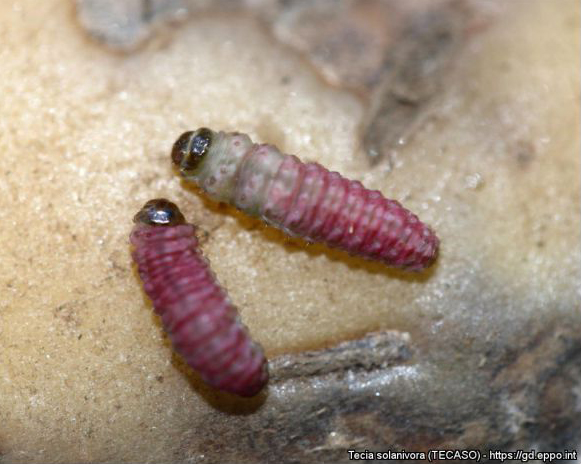
Larvae in the 4º stage
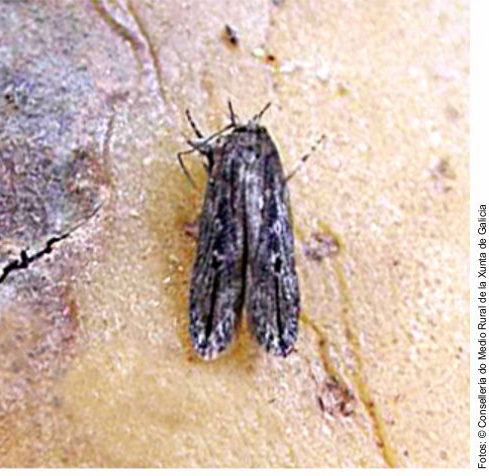
Adult
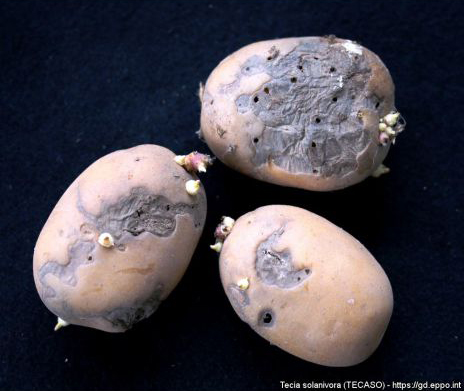
External damage
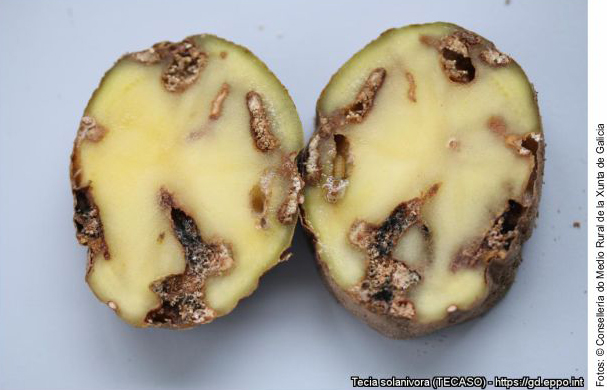
Internal damage
Once outside the potato, the larva stops feeding on it and forms a silk cocoon with particles of different materials in which the chrysalis (pupa) remains inside.
This phase can occur in the ground (soil), in sacks containing potatoes, in fissures and cracks in the floors and on the walls of warehouses. It can also pupate inside the potato.
At first the chrysalis (pupa) is light brown, but when it emerges as an adult, it turns a darker colour. This phase lasts between 10 and 20 days.
The table above concludes that the moth can complete its lifecycle between 42 and 95 days, depending on the temperature.
Important facts of Tecia solanivora’s biology:
- At higher temperatures there are more generations, but also higher mortality rates.
- The minimum temperature for its development is between 7º C and 9º C.
- Temperatures below 10oC and rain are a limiting factor for its growth.
SOURCE: Consejería de Agricultura, Ganadería, Pesca y Alimentación de la Comunidad Autónoma de Canarias.
Detection and monitoring
1 to 3 traps per hectare should be placed at the same height as the crops or on an ECONEX TRAP SUPPORT (Code: UIPFETA051).
The traps should be placed as soon as the Tecia solanivora populations increase during the crop cycle. This usually happens during the process of tuberisation; therefore it is recommended to place the traps from the flowering period to harvest time.
The traps should be placed at an approximate height of 30 to 60 cm from the ground. The maximum height will be determined by the growth of the plants (if the traps are placed too low, once the crops have grown it will be difficult to find the traps).
The traps should be placed in the field paying special attention to the plot borders, where the populations increase much faster. Also, if the traps are placed inside the plots, due to the high density of the potato crops, it is difficult to service the traps.
Mass captures
In potato crops:
For mass trapping, the number of traps per surface area must be increased, depending on the location and uniformity of the plots. One trap controls a surface area between 500 and 1.000 m2. This means a density of 10 to 20 traps per hectare is needed.
Potatoes stored in warehouses:
For an effective use of the traps, it is necessary to know about the lifecycle of the pest.
The traps should be placed where the Guatemalan potato moth is most likely to be found and at specific points in the food production process, where fast detection of the insects is important.
In warehouses with a smaller quantity of produce stored, it is also advisable to place traps. In places where the activity of this pest is high, traps should be checked weekly to observe the number of insects caught. In other areas, the traps should be checked every 15 days.
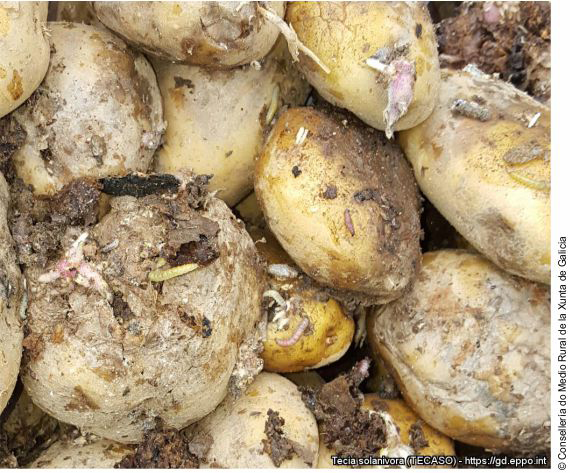
Damaged potatoes and Tecia solanivora larvae
In warehouses, the trap density varies between a minimum of 3 traps and a maximum of 9 traps per 1000 m². Enclosures near to the infested area should have traps, as well as the corridors that are connected to an infested area.
If the corridors come directly from the infested area, 2 traps should be placed one in front of the other.
Period of use
To obtain good control of Tecia solanivora, it is advisable to combine two methods, which is detection and monitoring; and mass trapping.
1 or 3 traps per hectare should be placed to detect the pest and observe its population levels, 60 days before harvesting the potatoes.
With tolerance thresholds established in each area, the moment to adopt control measures, in this case mass trapping, can later be defined. The tolerance threshold for Tecia solanivora, is very low and varies depending on the area. In general, it is approximately 21 captures per trap and per week.
At this point we recommend the placement of traps throughout the plot to carry out mass captures.
Necessary material
An ECONEX POLILLERO, EOSTRAP®, ECONEX WHITE TRIANGULAR without sheets or ECONEX DISPOSABLE WHITE TRIANGULAR trap and an ECONEX TECIA SOLANIVORA 2 MG 60 DAYS pheromone diffuser.
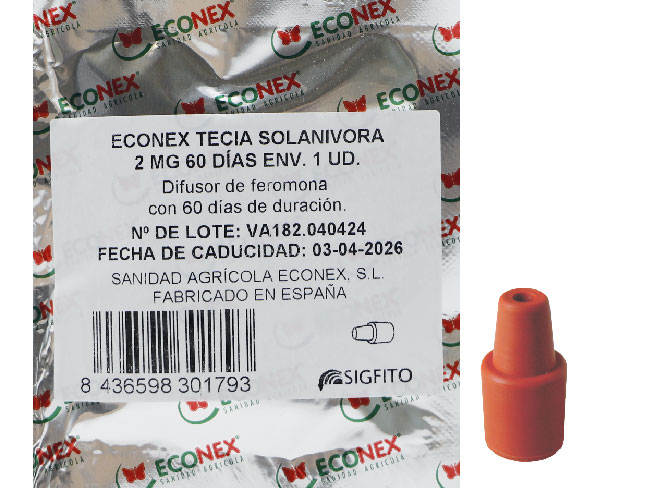
ECONEX TECIA SOLANIVORA 2 MG 60 DAYS
Sexual pheromone diffuser of the species Tecia solanivora to attract males, with a duration of 60 days in normal field conditions.
Code: UIPHOVA182
OMDF register number (Ministry of Agriculture of Spain): 034/2017

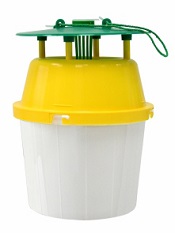
ECONEX POLILLERO
It is the most suitable trap for the majority of lepidopterans, especially large moths.
Code: UIPFETA001
OMDF register number (Ministry of Agriculture of Spain): 123/2015

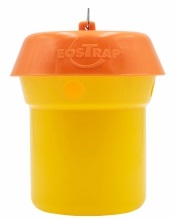
EOSTRAP®
The EOSTRAP® trap is made of easily-adjustable parts with natural refrigeration, aerial ventilation and diffusion of insect attractants by means of the Venturi.
Code: UIPFETA042
OMDF register number (Ministry of Agriculture of Spain): 143/2014

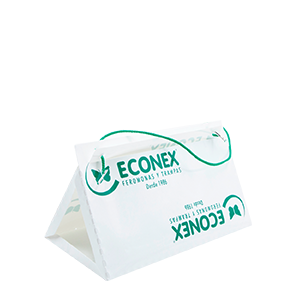
ECONEX DISPOSABLE WHITE TRIANGULAR
Code: UIPFETA242

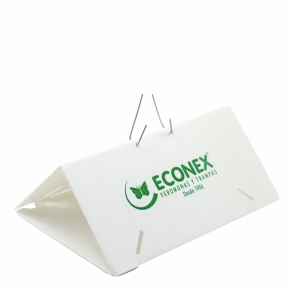
ECONEX FOLDING WHITE TRIANGULAR WITHOUT SHEETS
28x20x11 cm, hanger included.
Code: UIPFETA273
OMDF register number (Ministry of Agriculture of Spain): 064/2014

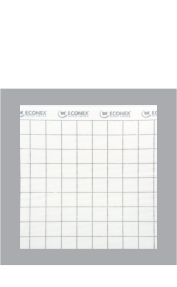
ECONEX SHEET FOR TRIANGULAR 1 UNIT
Sticky sheet of 20 x 19 cm.
Code: UIPFETA248
OMDF register number (Ministry of Agriculture of Spain): 048/2024

Both the ECONEX POLILLERO and the EOSTRAP® are more suitable than the ECONEX TRIANGULAR trap for mass captures. In the ECONEX POLILLERO and the EOSTRAP® traps, it is advisable to place a substance capable of killing or retaining the captured insects inside the trap, such as olive oil or sunflower oil.
The ECONEX WHITE TRIANGULAR WITHOUT SHEETS trap is activated by placing an ECONEX SHEET FOR TRIANGULAR (Code: UIPFETA248) on its base. The sheet is impregnated with a pressure-sensitive adhesive, without solvents, in which the insects remain trapped.
The ECONEX DISPOSABLE WHITE TRIANGULAR trap is coated on the inside with a layer of solvent-free contact adhesive, to keep the insects trapped.
Both traps stand out above all for their ease of use, and will remain operative until the pheromone runs out or the adhesive sheet (or surface) is saturated. The pheromone diffuser is placed inside the trap on the adhesive sheet (or surface).
Factors that influence in the number of traps needed
The pest population, bordering crops, the level of control required, etc.
One important factor is the size of the crops. In small and irregular crops, a greater number of traps are required than in larger and more uniform plots.
Another important factor is the distance between plots that have Tecia solanivora. In cases like this, the borders of the plots must be reinforced, so it could be necessary to place up to 20 traps per hectare or even more for mass trapping.
Storing the diffusers
The diffusers must be stored in their original packaging in a cool and dry place and separated from food and drinks.
To preserve the diffusers for long periods of time, it is recommended to keep them in the refrigerator at 4 o C in which case they will last for 2 years. Or they can be kept in the freezer at -20 o C for 4 years.
Diffuser packaging
ECONEX TECIA SOLANIVORA 2 MG 60 DAYS
Corrugated cardboard box of 3.000 units (150 packs of 20 units).
Box size: 0,60 x 0,40 x 0,35 m (length x width x height).
Box weight: 9,8 kg.
No. of boxes per pallet: 20
Pallet size: 1,20 x 0,80 x 2,00 m (length x width x height).
Pallet weight: 203 kg.
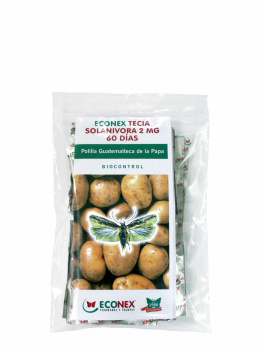
Pack of 20 units.
Includes a product information leaflet
del manejo del producto
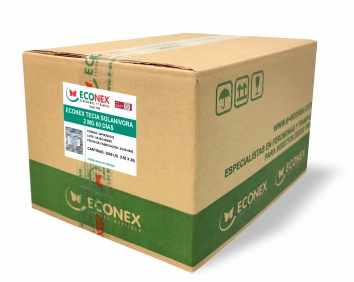
Box of 3000 units.
(150 packs x 20 units)
